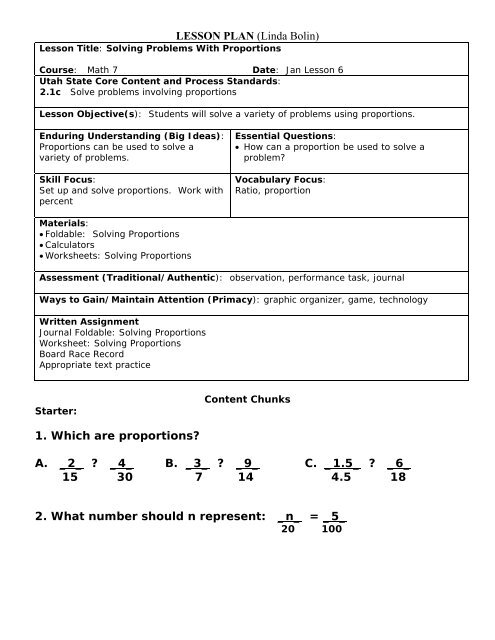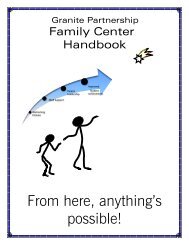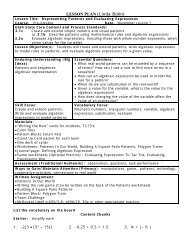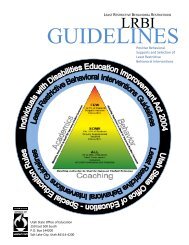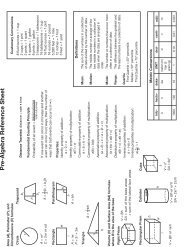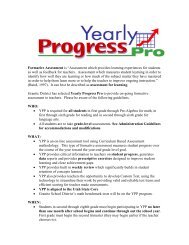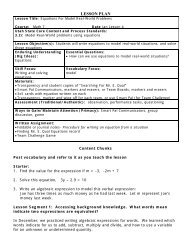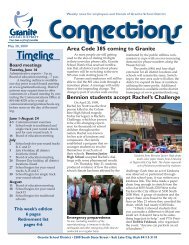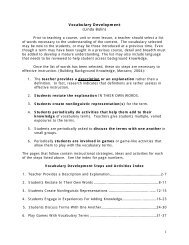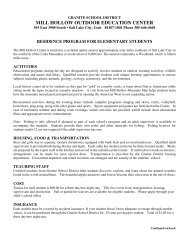LESSON PLAN (Linda Bolin) - Granite School District
LESSON PLAN (Linda Bolin) - Granite School District
LESSON PLAN (Linda Bolin) - Granite School District
You also want an ePaper? Increase the reach of your titles
YUMPU automatically turns print PDFs into web optimized ePapers that Google loves.
<strong>LESSON</strong> <strong>PLAN</strong> (<strong>Linda</strong> <strong>Bolin</strong>)<br />
Lesson Title: Solving Problems With Proportions<br />
Course: Math 7 Date: Jan Lesson 6<br />
Utah State Core Content and Process Standards:<br />
2.1c Solve problems involving proportions<br />
Lesson Objective(s): Students will solve a variety of problems using proportions.<br />
Enduring Understanding (Big Ideas):<br />
Proportions can be used to solve a<br />
variety of problems.<br />
Skill Focus:<br />
Set up and solve proportions. Work with<br />
percent<br />
Essential Questions:<br />
• How can a proportion be used to solve a<br />
problem?<br />
Vocabulary Focus:<br />
Ratio, proportion<br />
Materials:<br />
• Foldable: Solving Proportions<br />
• Calculators<br />
• Worksheets: Solving Proportions<br />
Assessment (Traditional/Authentic): observation, performance task, journal<br />
Ways to Gain/Maintain Attention (Primacy): graphic organizer, game, technology<br />
Written Assignment<br />
Journal Foldable: Solving Proportions<br />
Worksheet: Solving Proportions<br />
Board Race Record<br />
Appropriate text practice<br />
Starter:<br />
Content Chunks<br />
1. Which are proportions?<br />
A. _2_ ? _4_ B. _3_ ? _9_ C. _1.5_ ? _6_<br />
15 30 7 14 4.5 18<br />
2. What number should n represent: _n_ = _5_<br />
20 100
Lesson Segment 1: How can a proportion be solved?<br />
We know we can recognize two ratios that form a proportion by dividing each to<br />
determine if the quotients are equivalent. There is another way we can recognize a<br />
proportion. Show students how to find cross products in a proportion by having them<br />
find cross products on the Starter questions. Then show them how to solve # 2 on<br />
the starter using cross products rather than using guessing and checking.<br />
Board Race Game: Make a space for each of 8 or 9 teams to write on the board.<br />
Number students on a team 1-4. Put a proportion for the class to solve on the<br />
overhead. Students work together using the cross products method for setting up<br />
and solving the proportion equation. After they have had a chance to work on the<br />
problem with their team or partner, say, “Person # 3, GO”! The person on each team<br />
who is that number quickly moves to the space you have made for the team on the<br />
board, sets up the problem, solves, and checks it. Then, the person moves quickly<br />
back to their seat. Note the first four to finish. When all have returned to their seats,<br />
have class look to see who worked the problem correctly. Give a point to any of the<br />
first four completed, who have correctly worked the procedure. Repeat with another<br />
problem, this time calling a different student number to come to the board, etc.<br />
Lesson Segment 2: How can a proportion be used to solve real-world<br />
problems?<br />
Students use Smart Pals and the reading strategy to set up and solve the problems on<br />
the “Proportion Problems” worksheet. Once the Smart Pals have been shown to the<br />
class, have them record the problem on their worksheet. Reading Strategy: Have<br />
students each read a problem and share with a partner what they think is, a) the key<br />
information in the problem, and b) what the question is asking them to find. Ask two<br />
pairs to their share ideas with class for each problem. Once students have identified<br />
key information and the question, the teacher should do a think-aloud modeling how<br />
to determine what information will be placed in what position on each ratio to form a<br />
proportion.<br />
Journal: Make the Solving Proportions Foldable with the students. This is a center<br />
fold, where the two outside quarters fold toward the center to make doors.<br />
Assign appropriate text practice
Proportion Problems<br />
Name__________________<br />
Instructions: Set up proportions to solve these problems.<br />
1. Mr. Daniels drove 336 miles in eight hours. If he maintains this same speed, how<br />
many miles can he drive in 14 hours?<br />
2. An airplane travels 975 miles in three hours. How many hours will it take to go<br />
1300 miles?<br />
3. An umpire records five hits for every twelve boys at bat. If 180 boys come up to<br />
bat, how many hits should be made?<br />
4. On a trip of 768 miles, Tonie used 48 gallons of gasoline. How many gallons<br />
would be needed to go 1168 miles?<br />
5. If Mario earns $51 in three weeks, how many weeks will it take him to earn 852?<br />
6. 2700 bricks are needed to build 300 square feet of a wall. How many bricks will<br />
be needed to build 1800 square feet of wall?<br />
7. If it takes ten people six hours to assemble 100 Walkmans, how long would it<br />
take them to assemble 500 Walkmans?<br />
8. Two out of five high school graduates attend college. If three hundred seventyfive<br />
graduate, how many will attend college?
Step # 1<br />
First Ratio<br />
Step # 2<br />
Second Ratio<br />
Step # 3-<br />
Solve an Equation<br />
Step # 4-Check<br />
and Answer<br />
Read the problem<br />
carefully!<br />
Look for two<br />
numbers to compare<br />
as the first ratio.<br />
You need three parts<br />
water for one part<br />
orange juice<br />
concentrate.<br />
If you have 12 cups<br />
of water in a pitcher,<br />
how much O.J.<br />
concentrate do you<br />
need?<br />
(__) parts water,<br />
1 part O.J.<br />
Find a third number that is<br />
representing the same kind of<br />
idea as one of the numbers in<br />
your first ratio.<br />
Write a second ratio by<br />
placing this number in the<br />
same position you wrote it on<br />
the first ratio (numerator or<br />
denominator). Put a variable<br />
on the second ratio in the<br />
other position (numerator or<br />
denominator).<br />
water (__) = (__) water<br />
O.J. 1 j O..J.<br />
Multiply to get cross<br />
products that are equal.<br />
Solve the new equation.<br />
( ) ( )<br />
( ) ( )<br />
3j = ( )<br />
_3_ j = (__)<br />
3 3<br />
j = ( )<br />
Substitute the<br />
solution of the<br />
equation to check.<br />
Make sure both<br />
quotients or cross<br />
products are equal.<br />
Answer the<br />
question.<br />
_3_ = (__)<br />
1 ( )<br />
3( ) = 1( ) °<br />
___ cups of<br />
O.J concentrate<br />
are needed.
Step # 1<br />
First Ratio<br />
Step # 2-Second Ratio<br />
Step # 3-<br />
Solve an Equation<br />
Step # 4-Check<br />
and Answer<br />
Read the problem<br />
carefully!<br />
Look for two<br />
numbers to compare<br />
as the first ratio.<br />
You need three parts<br />
water for one part<br />
orange juice<br />
concentrate.<br />
If you have 12 cups<br />
of water in a pitcher,<br />
how much O.J.<br />
concentrate do you<br />
need?<br />
( 3) parts water,<br />
1 part O.J.<br />
Find a third number that is<br />
representing the same kind<br />
of idea as one of the numbers<br />
in your first ratio.<br />
Write a second ratio by<br />
placing this number in the<br />
same position you wrote it on<br />
the first ratio (numerator or<br />
denominator). Put a variable<br />
on the second ratio in the<br />
other position (numerator or<br />
denominator).<br />
water (3 ) = (12) water<br />
O.J. 1 j O..J.<br />
Multiply to get cross<br />
products that are equal.<br />
Solve the equation.<br />
( 3 ) ( 12 )<br />
( 1 ) ( j )<br />
3j = (12 )<br />
_3_ j = (12)<br />
3 3<br />
j = ( 4 )<br />
Substitute the<br />
solution of the<br />
equation to check.<br />
Make sure both<br />
quotients or<br />
cross products<br />
are equal.<br />
Answer the<br />
question.<br />
_3_ = (12 )<br />
1 ( 4)<br />
3(4) = 1(12) °<br />
_4_ cups of<br />
O.J concentrate<br />
are needed.
Proportions<br />
Solving


